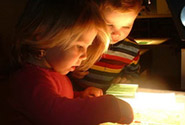A Clothespin for Every Side - Math at 21 Months

Why would a 21-month-old child find satisfaction in fitting wooden clothespins over the edge of a square plastic container? Before we look at her skill, we should speculate on what drives her to action. Too often we just start with the children's strategies and how clever they are. But throughout our years of observing children at Videatives, we have learned that making separate objects fit together and stay together has universal appeal to children. Also, children are naturally intrigued when they can make something stand in a vertical orientation by attaching it to or resting it on something else. Why and so what? Young children spend much of their waking hours exploring their world to determine if they are in the presence of one thing or two things. A hairbrush may have a skinny handle. Does the handle detach? A red plastic cup rests on a red plastic placemat. If lifted, will the cup separate from the placemat? This interest in exploring the difference between one thing and two things could well be hardwired into the brains of our species. Children's interest in making unstable things stand tall could also be hardwired. As teachers, knowing these instinctive drivers of action provides a good starting place for designing a rich problem solving environment for children, the way Montessori understood with her didactic materials how much children instinctively work to fill in a hole with the correct-sized peg. In this video, Vivian discovers how to attach two rather different objects. If properly placed, the clothespin will remain on the edge of the cup even after Vivian releases the clothespin. The clothespin becomes a part of the cup, and for that moment two can be treated as one. She separates the clothespin from the cup to affirm that what once was a whole is now two parts - or, two different wholes. Playing with objects is not just about fun. It is an early form of logic and a precursor to math. To make another connection to math, notice how Vivian repositions the clothespins now and then to create an arrangement of one clothespin on each side of the cup. Why would a child "edit" an arrangement this way? What says to the child, "Two clothespins on one side is not quite right?" We do not know, but here again this tendency to establish a one to one correspondence among objects could well be hardwired during the evolution of our species. These are the natural beginnings of math and key actions for teachers to notice and support. The fact that the clothespin stands tall and does not fall might be another driver of Vivian’s play. The clothespins become part of a larger whole, yet they remain conspicuous by the way they protrude from the sides of the cup. Thus, the paradox of being separate yet joined. Play along this paradox become irresistible for young children. And could it be that at the end of the video, Vivian generalizes this objective of making things stand tall? She rights the toy dinosaur to its vertical orientation. We are continually amazed at the young child's innate sense of what looks right and what needs to be changed. The source of that sense runs deep into what it means to be intelligent. Keywords: Ones, Child-Object, Math, Containers Length of video: 1 minute 50 seconds
